They say that a journey of a thousand miles begins with a single step but I would say that my journey of considerably less miles began with an Instagram photo that looked a little like this:

Nachi Falls and Sanjudo Pagoda
It turns out that the location in this picture is on a sacred UNESCO world heritage pilgrimage route (of which there are only two in the world, the other being Santiago de Compostela in Spain). The path in Japan is called the Kumano Kodo and has been used by pilgrims from all levels of Japanese society for over 1,000 years as they participated in religious rites of worship and purification on the difficult journey to Kumano through the mountainous Kii Peninsula in Wakayama, Japan. The main focus of the pilgrimage is to worship at the Three Grand Shrines of Kumano, known as the Kumano Sanzan: Kumano Hongu Taisha, Kumano Hayatama Taisha, and Kumano Nachi Taisha. There are actually four main pilgrimage routes along the Kumano Kodo and hiking the entire length is said to take around a month. I decided to take what is known as the “Nakahechi” route, running from west to east along the Kumano Kodo from Kii-Tanabe to Kii-Katsura, a route that was extensively used by the Imperial family since the 10th century on pilgrimage from Kyoto.
Getting There
For tourists visiting Japan, the route from Tokyo to the Kii Peninsula to start the journey in Kii-Tanabe for the Nakahechi route is completely covered on the JR Rail Pass first on the Tokaido Shinkansen to Shin-Osaka and then via the JR Kuroshio 7 Limited Express train to Kii Tanabe, which takes about two hours. If starting from the eastern side of the Kii Peninsula, it would be better to get off the train in Nagoya and take the JR Nanki Limited express to Kii-Katsura station, which takes about 3.5 hours.
There is an airport 15 minutes by bus from Shirahama station on the Kii Peninsula called Nanki-Shirahama airport, which has direct flights from Tokyo that take about 70 minutes and cost about 33,000 yen one-way. From Shirahama station, it is a 14 minute train ride on the JR Kisei line for 200 yen to get to Kii-Tanabe and start your journey.
For more specific information on routes, please see the Tanabe City Tourism Bureau.
My Plan
I spent five days in the Kumano Kodo and didn’t actually book anything until three days before my trip. This meant that I couldn’t book all of the most interesting accommodation that I found on the Tanabe Tourism website. If you’re coming to the Kumano Kodo, I would recommend booking at least three to even six months in advance to try to get a room at some of the smaller accommodations (for example, the most popular place in Koguchi called Minshuku Momofuku (for more info, click here), which only has four rooms).
Because I couldn’t get the Japan rail pass due to being a resident in Japan, I needed to pay all of train costs as I went and so decided to hike on my own rather than booking a guided tour. I do want to make a note here that these guided tours or even self-guided tour options are possible through several different sites (two being Inside Japan and Oku Japan) and help take care of the luggage side of things and booking accommodations while you do the hiking. While this is an efficient option, I will include my own costs in this post to give you an idea of the costs if you do the trip on your own.
Day 1
I left work at 8:45 pm, ran across the street to Tokyo station, and caught the 9:10pm Nozomi express Tokaido shinansen bullet train to Shin-Osaka station, arriving at 11:36pm. My accommodation for the night was the Shin-Osaka YHA Youth Hostel, a 10-minute walk from the station
Shinkansen ticket Tokyo to Shin-Osaka: JPY 14,450
Box dinner for the train bought at Tokyo station: JPY 1,000
Hostel: JPY 4,000 (including 500 yen breakfast)
Total: 19,450
The youth hostel was clean, spacious, and included a traditional Japanese breakfast, which I spent with 50 boys on a class trip from Singapore. Twin rooms are available. This is a perfect place to stay if arriving late in the night and you just want something that is an easy walk from the station and is reasonably priced. I used booking.com to find and book the accommodation. If work back in Tokyo hadn’t been a priority, I definitely wouldn’t packed another day or two into my visit.
Day 2
I had breakfast with the 50 Singapore boys, walked over to Shin-Osaka station and bought a ticket on the JR Kurashio express to Kii-Tanabe (total journey 2 hours). I met a handsome Japanese doctor on the train platform who started talking to me and then I actually missed my first train (something I’ve never done)! Thankfully, there was one more train to Kii Tanabe before my bus to Yunomine Onsen from there, and the doctor then asked if he could join me in the free seating car instead of the reserved car for the next train. It was revealed on the train that the doctor lives in Wakayama and called himself a “bone doctor” in Japanese (then showing me a photo of him holding up a skeletal arm at a conference to prove it). The doctor offered to drive me all around Wakayama if I got off the train with him, and while I realized that I was actually living out my favorite film ever (Before Sunrise, by Richard Linklater) in real life, I decided to keep going and said goodbye, not wanting to miss the Kumano Kodo (the bone doctor and I did meet again six months later, as the actors plan to do in Before Sunrise, but that is another story).
I arrived in Kii-Tanabe just before lunch and took a look at the Tanabe tourism office, which proudly displays the connection with the other famous pilgrimage route of Santiago do Compostela, bought my bus ticket from a machine inside this office, grabbed a great lunch while waiting for my train, and boarded the bus at 12:35pm at Kii-Tanabe station, arriving in Yunomine Onsen (actually the Shimoyunomine onsen bus stop for my hotel) at 2:25pm. Here is a bus timetable for your convenience
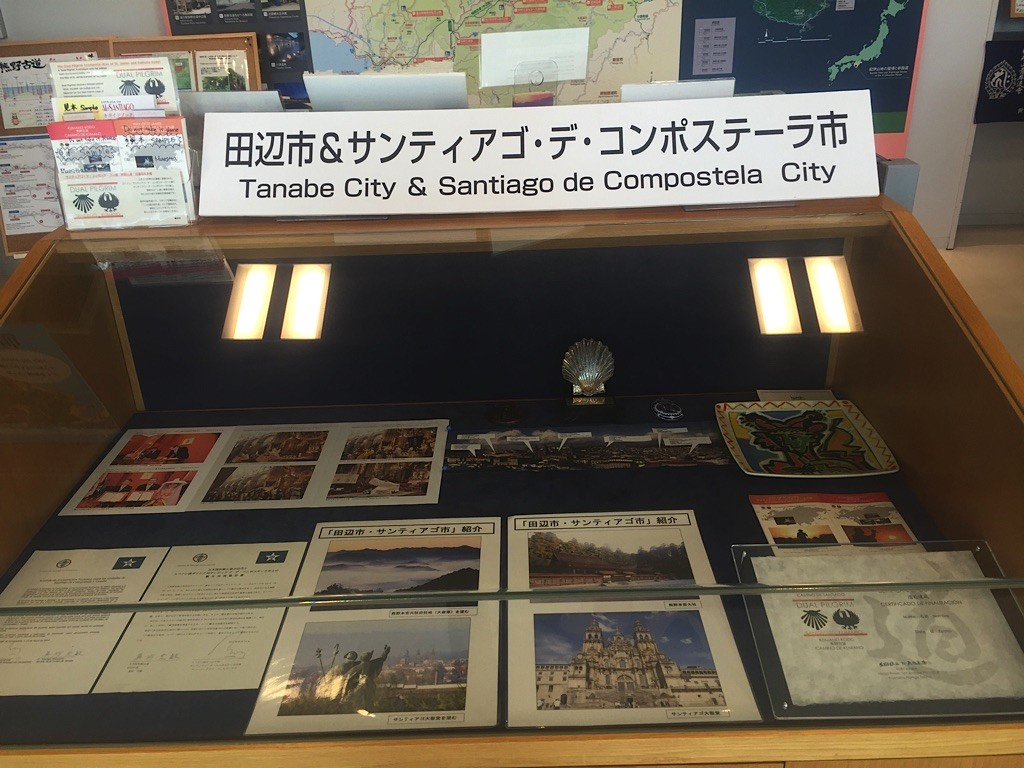
Sister pilgrimages – Kumano Kodo and Santiago de Compostela – getting ready to start the journey
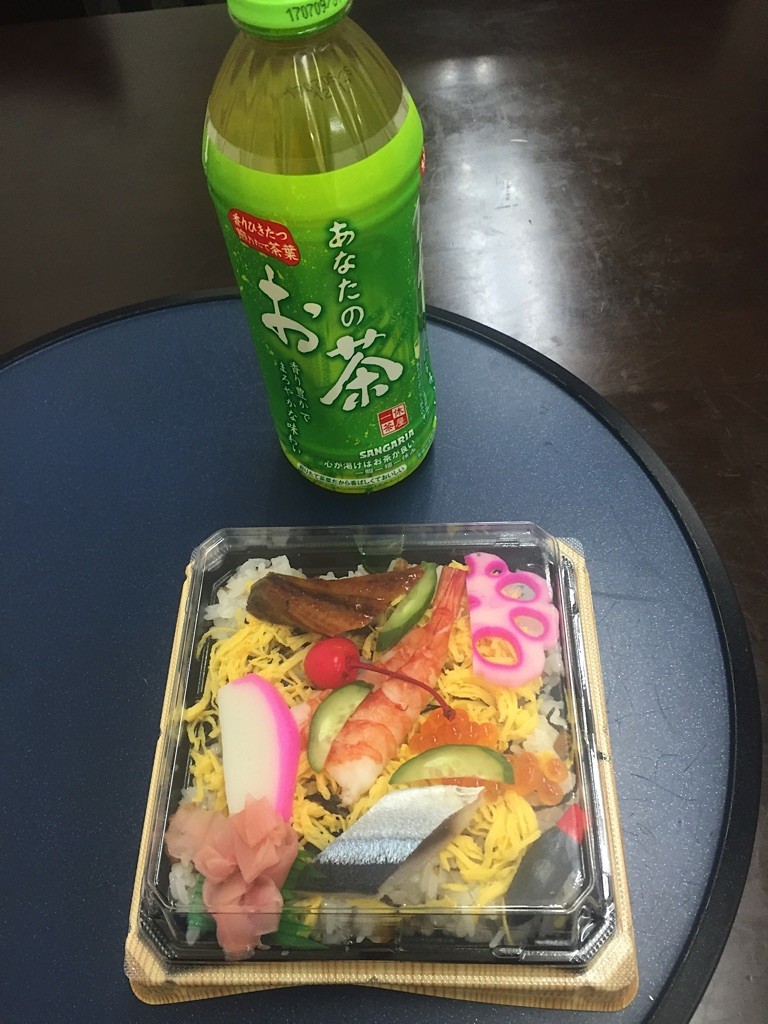
A quick bento lunch outside of Kii Tanabe station before catching the bus to Yunomine Onsen
The bus ride to Yunomine Onsen was gorgeous with lots of beautiful trees along most of the route. The other seven people on the bus all got off at Takijiri, which actually has the Kumano Kodo welcome center and is considered an official start to the trail. I would’ve loved to start there, but my five-day trip in the region only allowed me to go directly to Yunomine Onsen. This would make a perfect first day for hikers with more time. I arrived at the wonderful Yunominesou Japanese inn (known as a ryokan) and checked in around 2:30pm, dropped my bags off, and a woman named Sheri showed me my room and explained the bus timetable.
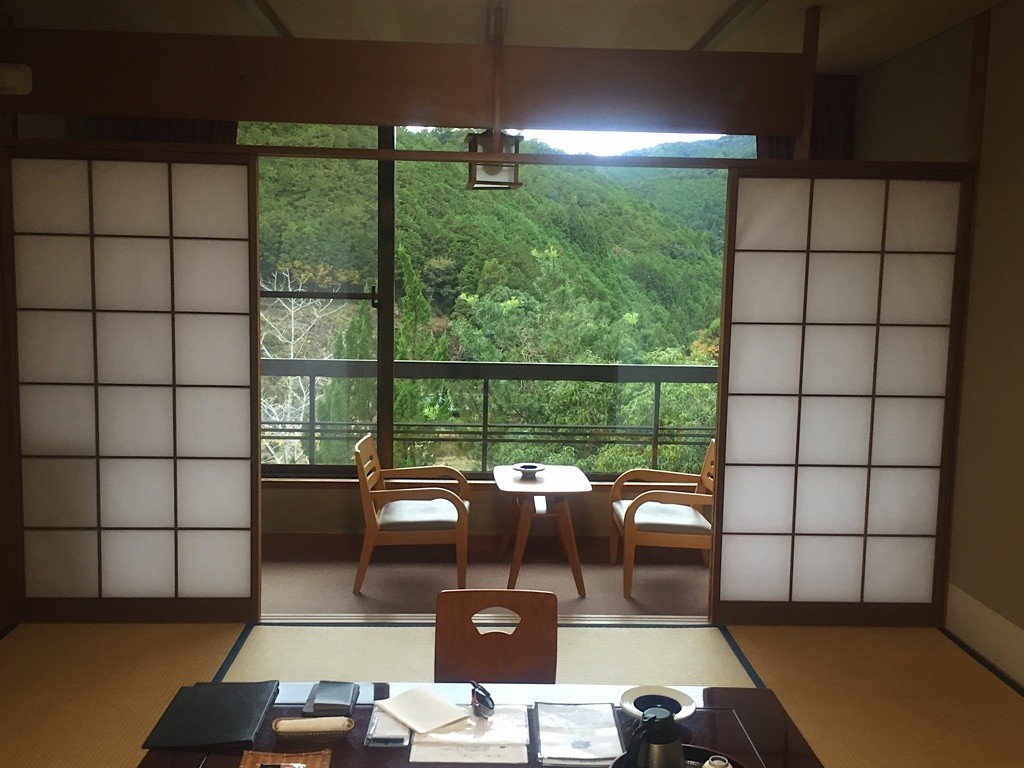
My room at the wonderful Yunomine-sou Japanese ryokan in Yunomine Onsen

Cooking eggs in that Yunomine Onsen water
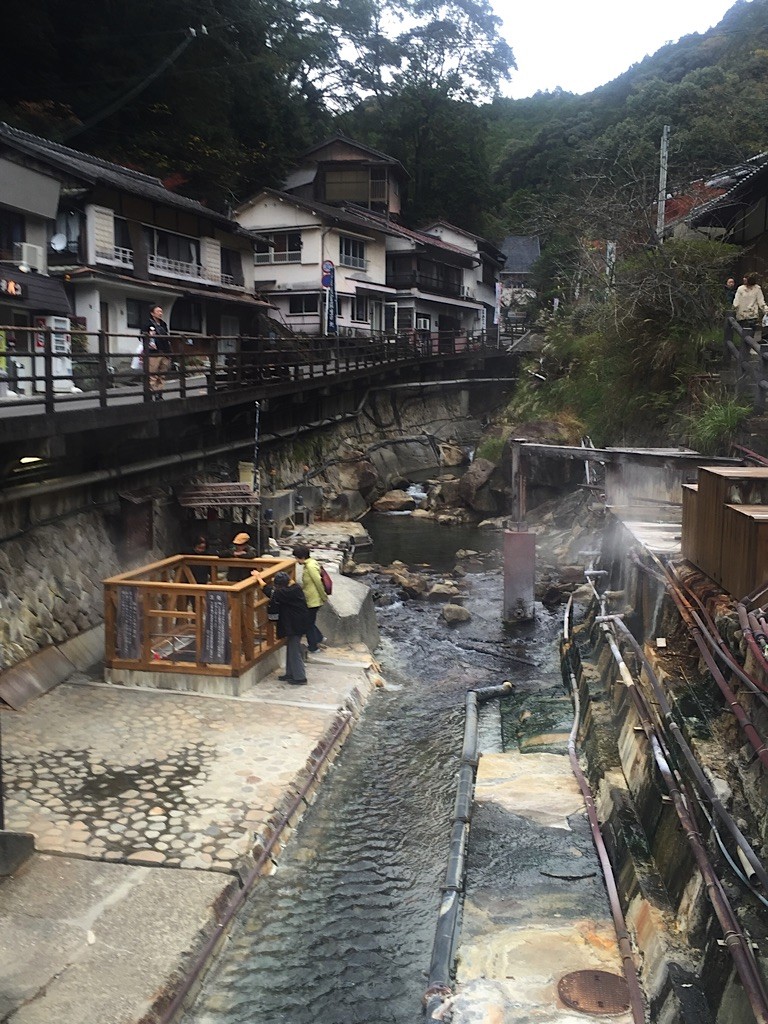
The gorgeous Yunomine Onsen town
I then took off for my first solo hiking since Brazil in 2012 (which, mind you, was only one hour but included huge, ominous jackfruits hanging from the surrounding trees and unidentified crawling creatures). The first thing I saw, as I entered the hiking trail down the hill from Yunominesou, was this:
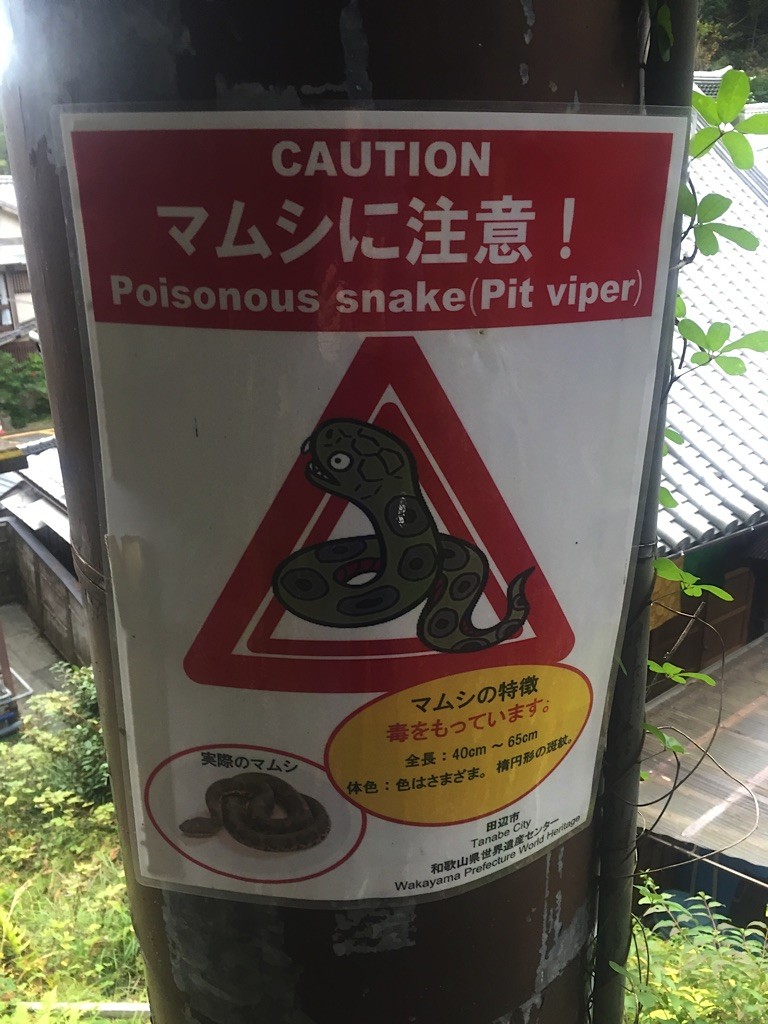
Thank goodness for the bear bell that jingled its way through the forest with me – no pit vipers were actually spotted =)
As I continued on the trail, however, I started seeing this:
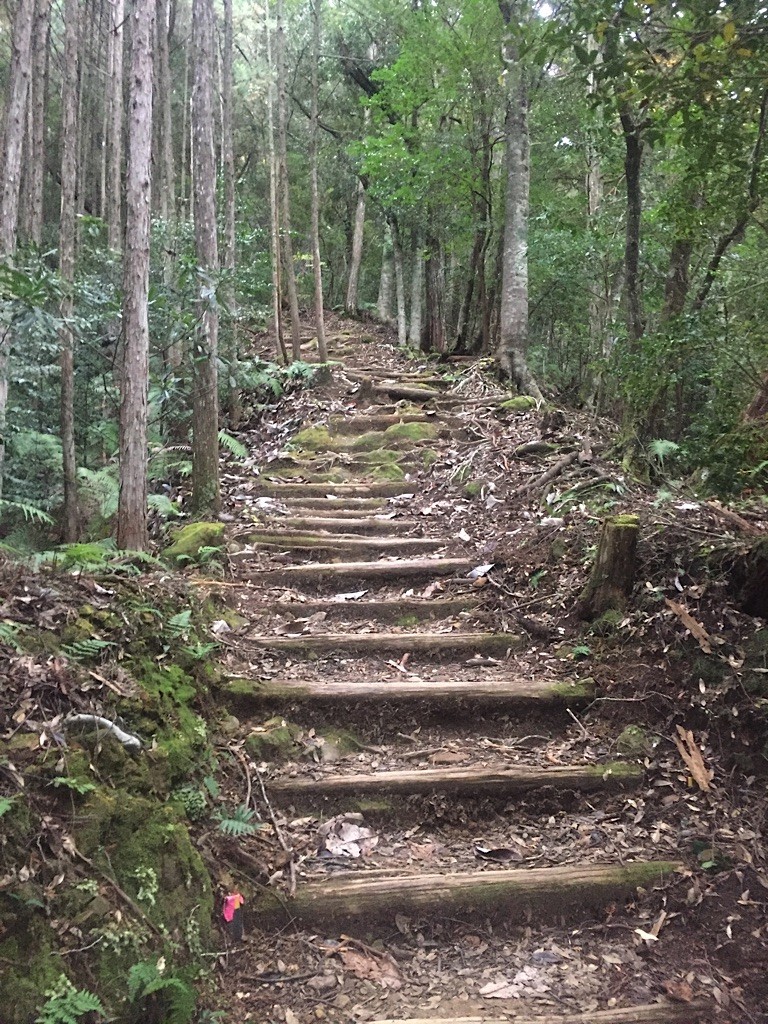
All alone in glorious nature
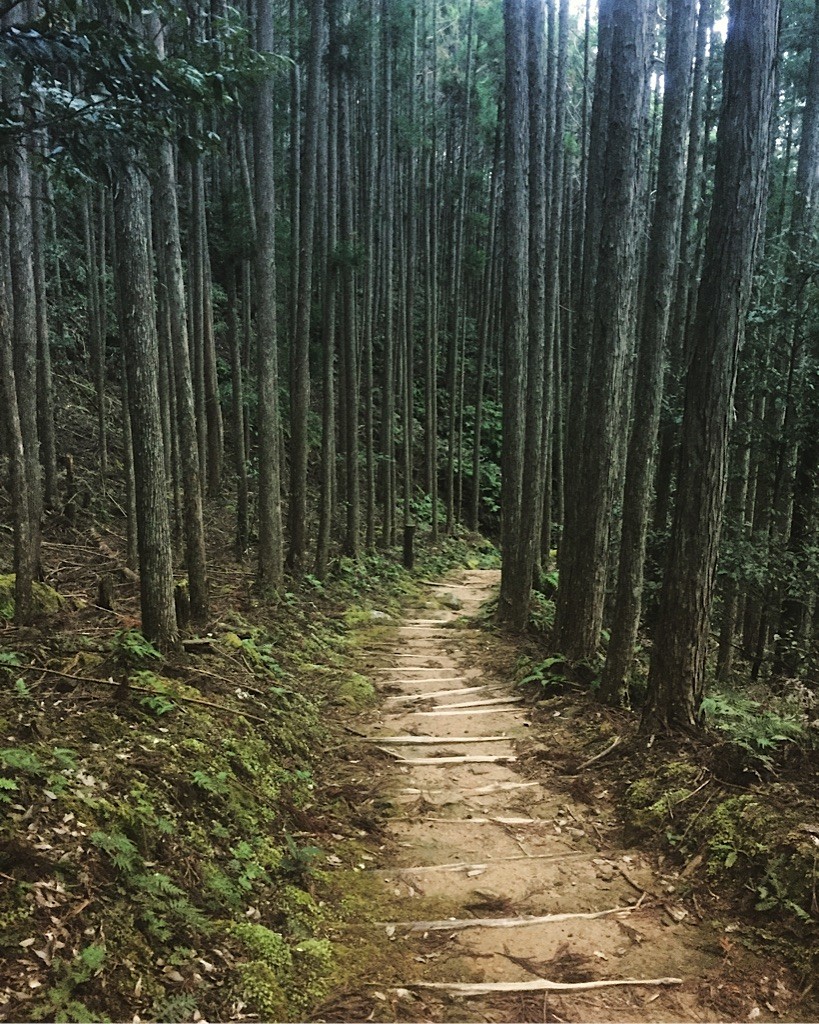
Unforgettable….that’s what you are
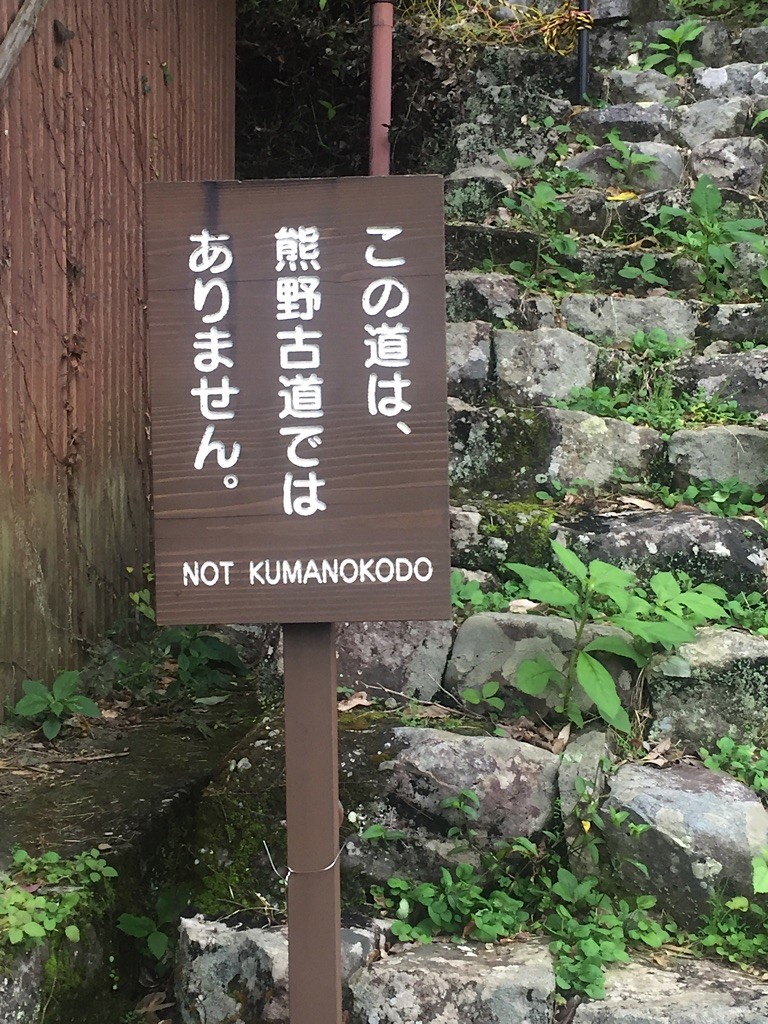
Keeping you on the right path
I continued my way to one of the Kumano Kodo’s famous shrines, Kumano Hongu Taisha as well as the world’s largest torii gate, a close walk from the shrine. The total walk took me about 1 hour and 15 minutes and was about 4.5 km.
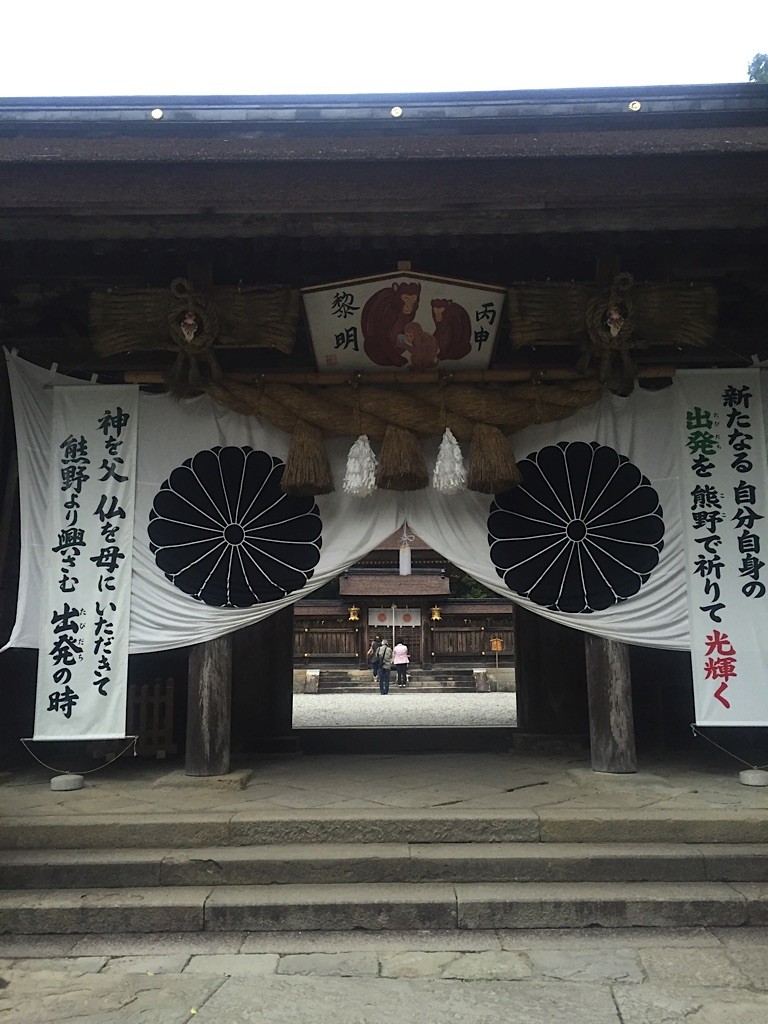
At the entrance to Kumano Hongu Taisha

The largest torii gate in the world at 33.9 meters tall in front of Oyu no Hara
I took one of the last buses for the day back to Yunomine Onsen just before dark and went to the basement of my hotel for one of the best dinners of my life, including a nice chat to one of my fellow American Kumano pilgrims who I had helped get off at the right bus stop for my hotel. He was lovely to talk to as we both enjoyed our traditional kaiseki style meals.
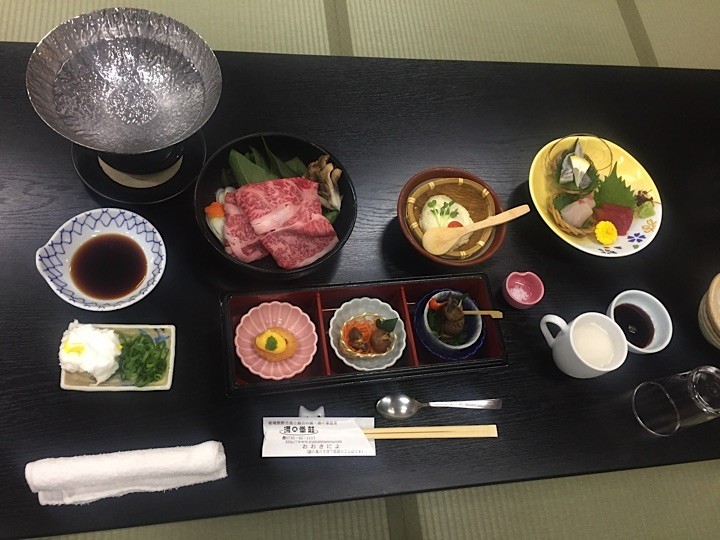
My wonderful meal at Yunomine-sou. Worth the splurge to stay here for a night on the trail. They kept bringing more and more courses just when I thought I was done, and eventually the big daddy:

In Japan, you’ve got to be prepared to eat anything
After dinner, Sheri called down the street to a place called Tsuboyu, Japan’s smallest and also one of the oldest hot spring baths in the entire country. Tsuboyu is a private hot spring that can take up to two people at a time and requires buying a ticket from a separate building near the bath and then getting a number to wait outside the small building to wait your turn for your private bathing experience. The water in Tsuboyu is said to be seven different colors throughout the day and I felt so excited to have a chance for a night bathing experience. Sheri told me that they weren’t busy at the time, handed me a flashlight, and off I ran down the road into the main part of town to get my ticket. The bath is open from 6am – 9:30pm every night, so I knew that I didn’t have much time to soak it all in. It was so great to run through the town in my yukata robe provided by the hotel, and I must say that Yunomine Onsen really made me feel like I was in the traditional countryside of Japan.

Directions right next to the Tsuboyu building
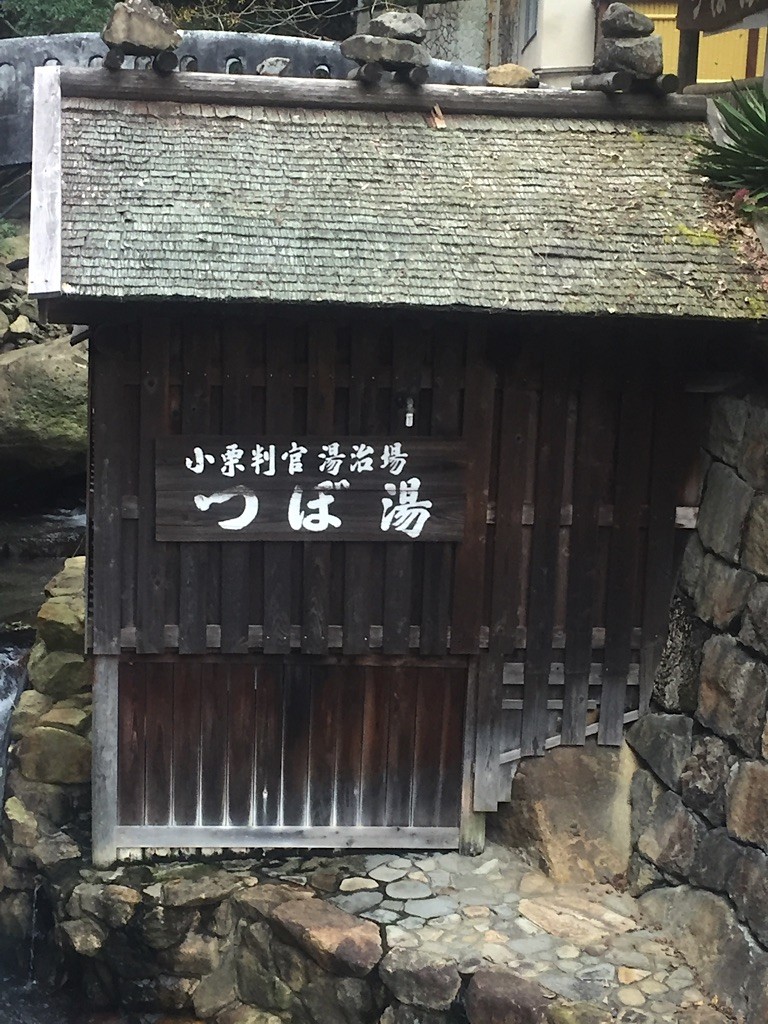
Tsuboyu, one of Japan’s oldest hot springs in the beautiful little town of Yunomine Onsen
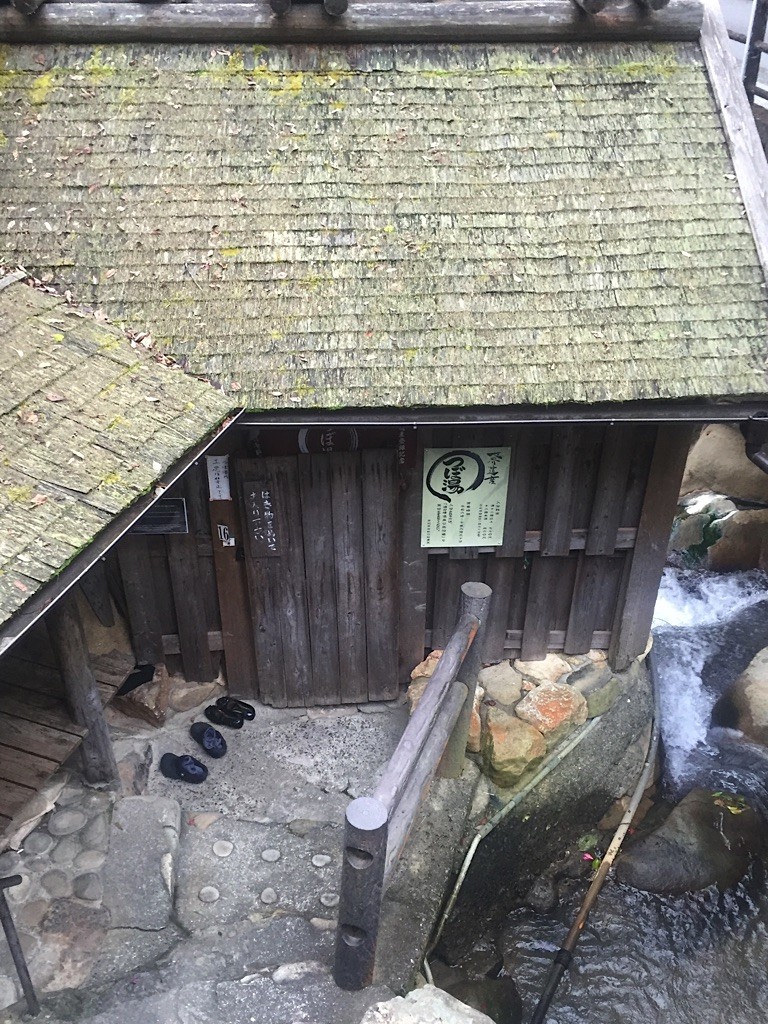
The waiting area of Tsuboyu. Put your number up on the wall just to the left of the door when it’s time to go in

Your own private onsen (hot spring) in Tsuboyu

My own private bath for 30 minutes. The next person in line was a young university student and he kindly took this picture of me.

This water was hot, but I found no river creatures in the water so all was well!
Total costs for Day 2:
JR Kurashio (included in the JR rail pass, but I had to pay) – JPY 5,470
Bus ticket from Kii-Tanabe to Yunomine Onsen – JPY 1,940
Lunch in Kii-Tanabe – JPY 600
One night at Yunominesou – JPY 17,500 including breakfast
Dinner at Yunominesou – JPY 4,000 (around this price)
Tsuboyu Bath Ticket – JPY 770
A lucky purple stone at Kumano Hongu Taisha: JPY 300
Total: JPY 30,580
Day 3
After another great breakfast at Yunominesou, my splurge was over for the trip, and I prepared to take a bus at around 8am from Yunomineonsen to Ukegawa (about a 10 minute ride) to begin my much longer hike compared to the previous day. I thought that I would be hiking alone but met a friendly Dutch solo female traveler waiting for the same bus and we decided to hike the entire way to Koguchi together, which is about a 13 km walk and takes about 4.5 hours. When we reached Ukegawa, we both stopped to get a pack lunch from the small convenience store right across from the bus stop. I bought water, an apple, a chocolate bar, and a couple of sandwiches and hoped it would be enough for the trail. I honestly felt that this section of the Nakahechi was not difficult and didn’t have too many uphill sections, though it did offer some beautiful views. I think my trip was greatly helped by such an entertaining hiking companion who was doing some long-term travel on her own turned out to be a published author from the Netherlands. I enjoyed hearing her story as I hiked along on Day 3.

On the trail from Ukegawa (10 minutes from Yunomine Onsen) to Koguchi (13 km). It took us about five hours.


Very nice eco-toilet

One of the many places that you can get stamps along the way

A great traveling companion from Ukegawa to Koguchi – Day 3
Our journey to Koguchi took us about 4.5 hours including a stop for lunch, and we were definitely helped along the way by our English trail guide map that we had both picked up back in Tanabe. This map is very helpful and I definitely recommend picking one up, as Google Maps may not be able to help you in the forest and in places with spotty WiFi. My Dutch friend had booked accommodation in Koguchi, which is a popular stopping point for the day, but my AirBnB was in a town called Kowase, only one bus stop from Koguchi and a 10 minute drive but the next bus wasn’t for another three hours when we arrived, so I decided to hike the rest of the way, another 6.5 km from the bus stop and about a 1 hr and 15 minute hike. I must say that I didn’t mind the walk, as I passed a beautiful river, was surrounded by trees on all sides, and didn’t pass a single other person walking on the road.

On the 8 km walk from Koguchi to the Sansaro Cafe, my AirBnB for the night. In my almost two hour walk, I saw one other person on the road.

One of the most beautiful rivers that I have seen in Japan along the trail to my AirBnB
I arrived to my AirBnB for the night at around 4pm and found my host at her home, which is just beside her cafe that she runs with her husband. I was shown my own room inside the family home, which had a bathroom right outside in the hallway, but interestingly enough no bath or shower facilities that I could use. These were a five-minute walk away at a public bathhouse facility overlooking the river and mountains and cost 500 yen. No complaints as the walk was totally refreshing and the outside bath was gorgeous and I only found two other women in the entire bathhouse. I truly was out in the countryside now. Fukami was an absolutely amazing host and a skilled vegan and vegetarian chef, as her son had allergies as a baby and she needed to prepare special meals for him. Not only did she prepare me an amazing dinner and breakfast, but she also prepared a pack lunch for me on my long hike from Koguchi, as there were no shops along the way and you must bring your own food. I was happy to pay extra for all of her wonderful meals. Fukami also has her own scrapbook full of places to see in her local area of Wakayama and showed me several that caught my eye (including one that would come back again two days later).
I loved Fukami’s story of moving to this rural location after the Tohoku earthquake, tsunami, and nuclear power plant crisis in Fukushima in 2011. She had led a busy city life in Osaka with her husband and young son before the earthquake, but, as she said, “We weren’t really living. After the earthquake, I asked myself, “What kind of life are we really living always busy and rushing around surrounded by city? I want to be able to see my son and spend more time with him. I searched for the safest place to live, somewhere where I could be in nature every day, and I chose this place of Wakayama, as it’s close to the sea and the mountains and this river here and my son now walks to school five minutes up the hill and we know all of our neighbors, we don’t lock our doors and don’t have to take the train.” Fukami’s story of Wakayama actually turned out to be so compelling that she was chosen to be a model on a poster about living in Wakayama that was displayed throughout Japan. That poster proudly hangs on her cafe wall. I can never thank Fukami enough for her hospitality in her beautiful little town. I would love to see her again one day.

Home for night 3 on the Kumano Kodo. I couldn’t have asked for a better AirBnB in such a remote place.

The Sansaro cafe–full of musical instruments and vegan food

The view from my AirBnB at Fukami’s house

Fukami is a wonderful cook and specializes in vegan and vegetarian food. This was actually my Thanksgiving feast.

The next morning, Fukami and her dog Haru saw me off at the bus station to catch the bus back to Koguchi to start my journey to Nachi Taisha
Total costs for Day 3:
Bus ticket from Yunomine Onsen to Ukegawa – JPY 240
Lunch from the convenience store – JPY 700
One night at AirBnB in Kowase – JPY 7,500 including dinner, breakfast, and pack lunch
Here is the link if you’d like to stay with Fukami
Kowase Bath Ticket – JPY 500
Total: JPY 8,940
Day 4
Fukami and her dog Haru saw me off the next morning, and I took the bus back to Koguchi and started my long 14.5 km walk from Koguchi to Nachi Taisha. This was really the day where I hiked almost the entire length of the trip by myself and the beginning of this section is by far the toughest of the Nakahechi route, as the first two hours or so are all winding uphill. There were times that I never thought that I would reach the top, and this was made stronger by my decision to carry as much weight as I did with me (pack as light as possible – pro tip!). I will also say that this section of trees was almost unreal in its beauty. I felt completely absorbed in the forest and only saw one other person on this early morning stretch of the trail.

Abandoned school right at the beginning of the trail. There is a bathroom you can use right behind this school.

The population of Japan is shrinking and many schools have closed, including this one

The start of the hardest part of the Kumano Kodo on Day 4 – winding uphill for almost two hours

Nature all to myself

Stone statues along the trail

I love the trail design

Prayer flags even on the Kumano Kodo

The top of the trail and start heading downhill from here

More gorgeous Kumano Kodo – Day 4

I couldn’t have asked for a better lunch – thanks, AirBnB mom Fukami!

These signs help you count down your way to Nachi

Feeling a little loopy at the end of the trail, just above Nachi Taisha. It was still another 20 minutes or so from here to the bottom
At the end of the trail, I finally came upon the picture that I first saw on Instagram a few months before, only this time it was my own picture.

Nachi Falls and Sanjudo Pagoda
In this same area (your reward for making it this far), you can see the following:

The beautiful Kumano Nachi Taisha shrine not far from the waterfalls and pagoda


Many of the temples and shrines in Japan have been refurbished or rebuilt due to fires or earthquakes. This one was the first I’d seen that seemed to be original – close to Kumano Nachi Taisha shrine

Nachi Falls is the waterfall in Japan with the tallest uninterrupted drop at 133 m.

The enchanting Daimonzaka part of the path below Nachi Taisha shrine at the bottom of the hill. This 600 m long path includes the most perfectly preserved part of the Kumano Kodo and is over 1,000 years old and lined with ancient cedar trees. Don’t miss it!
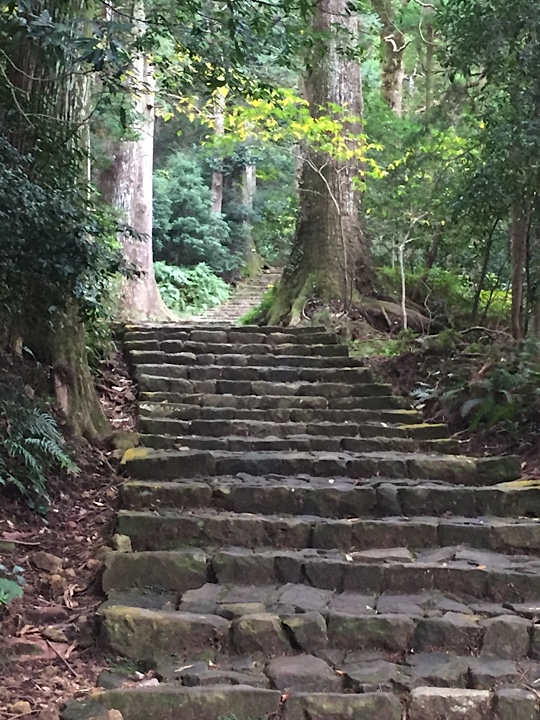
It was time to leave this unforgettable trail and catch the bus back to Kii Katsuura station, but I first stopped at a place with a great view of the Sanjudo Pagoda and had a delicious drink to celebrate!

A traditional fermented rice drink called “amazake” to celebrate finishing the trail
I took the bus back to Kii-Katsuura station around 4:30pm and checked into my hotel for the night, one of the cheapest that I was able to find in this port city called Onsenminshuku Kosakaya. I had booked it for the little bath within the hotel, as I was looking forward to it after my long hike to Nachi. Unfortunately, the bath for women was small and was actually just a slightly larger than a normal bath tub. I asked the hotel staff if there were any other good hot springs in the area, and he quickly said, “All are too expensive – like JPY 1,000 just to go in.” Undeterred on my quest to find something better, I went back to my room and started to Google around the area and, much to my surprise, I discovered that an amazing cave hot spring that I had seen in Fukami’s scrapbook was actually a five-minute ferry ride from the port by Kii-Katsuura station. Based on information that I could find, it seemed that I could visit the cave hot spring in a large hotel called Urashima and just pay the JPY 1,000 for the hot spring and not have to pay for a stay at the hotel. When the Kosakaya staff said JPY 1,000, I didn’t think that they were talking about a cave hot spring in a huge hotel. This was going to be worth it, and I made plans to visit right after checkout the next morning.
Total costs for Day 4:
Bus ticket from Kowase to Koguchi – JPY 240
A warm glass of Amazake – JPY 500
Bus ticket from Nachi Taki-mae to Kii-Katsuura – JPY 620
One night at Onsenminshuku Kosakaya – JPY 7,500 including JPY 2,500 for dinner
Total: JPY 8,860
Day 5
I checked out of my hotel at around 10am, walked ten minutes back to the train station and put my large bag into a locker. I then walked five minutes over to the port and waited to catch one of the most adorable ferries that I’d ever seen to go to the Urashima Hotel, which is on its own island.

The impossibly cute ferry to the Urashima Hotel
Be careful about checking times for the ferry to the hotel, as there seem to be only one every hour and are subject to change. You need to also be sure about the ferry times back, especially if you are planning to catch a train later in the day. I was one of only three people that boarded the boat bright and early that Sunday morning, excited for my chance to see this amazing hot spring cave.

My AirBnB mom had clued me in to this hotel two days when she showed it me in a scrapbook of things from the local area. I never thought I would be able to visit it myself on the same trip.

The Urashima Hotel is a step back in time. It desperately needs updating and is much better as a day trip over on the ferry than a stay there.

An old model that I found on my way to one of the hot baths in the Urashima Hotel. It certainly does look like a James Bond island!
I do not recommend staying at the Urashima hotel, as it is overpriced for how outdated the interiors actually are. Let me give you an idea of what I mean:

My how far we’ve come…
This hotel came complete with orange and green marked pathways along the ground leading you to different sections of this huge complex. Nothing seems to have been updated since the 1970s, so if you’d like a step back in time and a feeling of what it must have been like in the Japanese bubble economy, please book a stay. I was happy with paying JPY 1,000 to check out four different hot springs. One thing to note about these hot springs is that are actually closed for servicing at different times of the day, so you really will need to hang around for a few hours minimum to gain access to all of the different hot springs. I can tell you that it’s definitely worth the wait, especially for less than 10 USD and a free ferry ride over. There was an appalling lack of food options, although a Lawson’s convenience store that was under construction should now be open. Eat at the port before you go.

In case you were wondering…

My first hot bath in such a cool location all to myself. I thankfully did not drop my iPhone into the water and snuck some of these shots in before anyone arrived

What a view!


The biggest cave hot spring in the Urashima hotel. One of the staff members saw me waiting for it to open and let me in early, giving me another chance to get photos and walk around the cave naked by myself =)


What a view #2

Escaping James Bond Island

I went to every hot bath and I have the stamps to prove it. Thanks for a wonderfully vintage time, Urashima Hotel
Total costs for Day 5:
Lunch in Kii-Katsuura – JPY 900
Onsen ticket at the Urashima Hotel – JPY 1,000
JR Kurashio from Kii-Katsuura to Shin-Osaka – JPY 7,090 (3 hr 48 minutes, in hindsight, I should have gone back via Nagoya on the JR Nanki, saving me about an hour in total back to Tokyo, but I actually wanted to spend a little bit of time in Kyoto on my final day, so I went via Osaka)
Box dinner on the train – JPY 1,000
Shinkansen ticket Shin-Osaka to Tokyo: JPY 14,450
Total: JPY 24,440
Grand Total Costs for 5 Days on the Kumano Kodo from Tokyo without a Japan Rail pass and completely self-guided:
JPY 92,270 – Note that this cost could’ve been significantly cheaper on a Japan rail pass and if I had skipped some of the nicer meals and opted for simpler meals. I also splurged on the ryokan on the first night, but it was totally worth it. A Tokyo resident could also save considerable time and pay slightly less if they fly directly to Nanki-Shirahama airport, but I was on a limited time schedule and flight times did not match up.
My trip to the Kumano Kodo was one of the most memorable trips that I’ve ever had in my entire time in Japan. I think this was greatly helped by how empty the trail actually was. I couldn’t believe how beautiful the scenery was including the mountains and the incredible forest trails, and, yet, it still seems undiscovered by the outside tourism world. I would love to come back one day and do the entire one month journey or even part of the trip again. I will always remember my first hike by myself and how at peace I felt in such a beautiful forest and on such a storied route in Japanese history. If you have the opportunity to add an extra week to your itinerary in Japan, or are looking for somewhere off the beaten path that offers hiking with amazing hot springs, come and experience the incredible place that is the Kumano Kodo.


